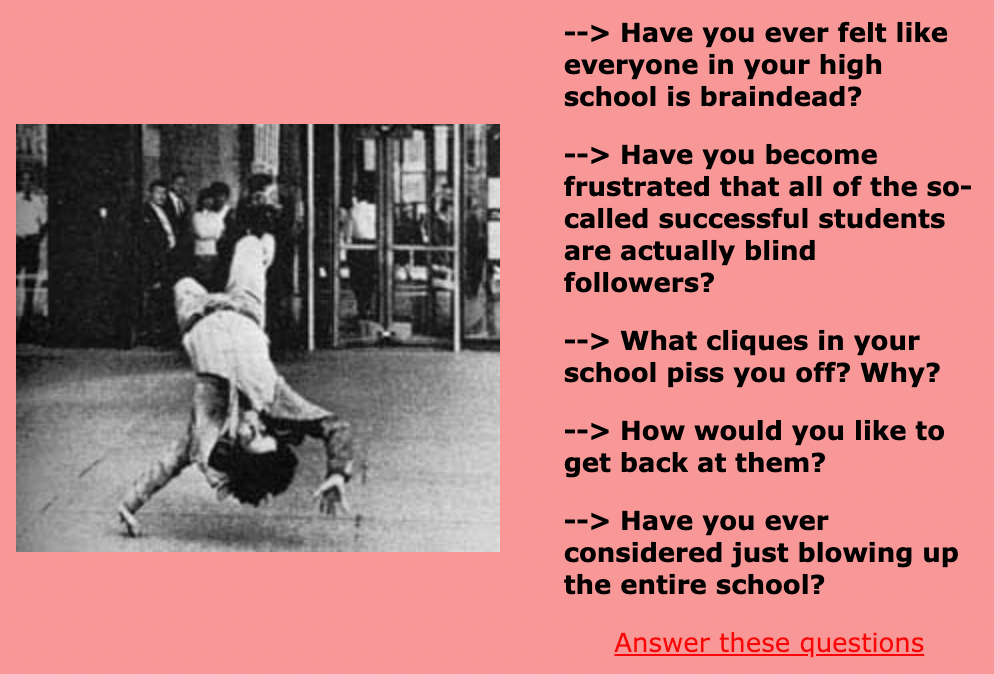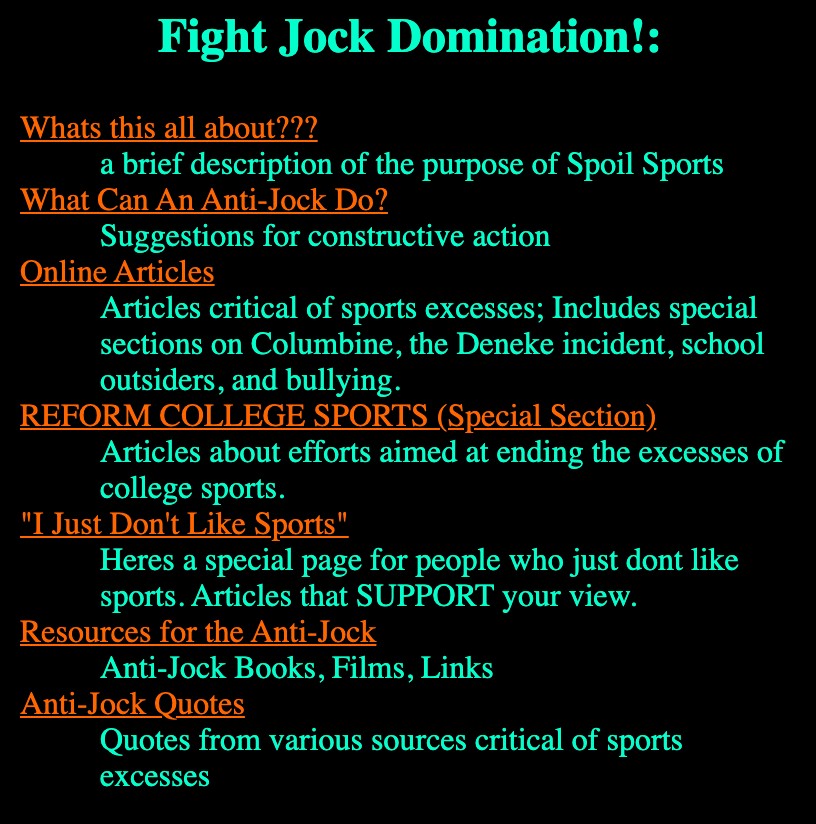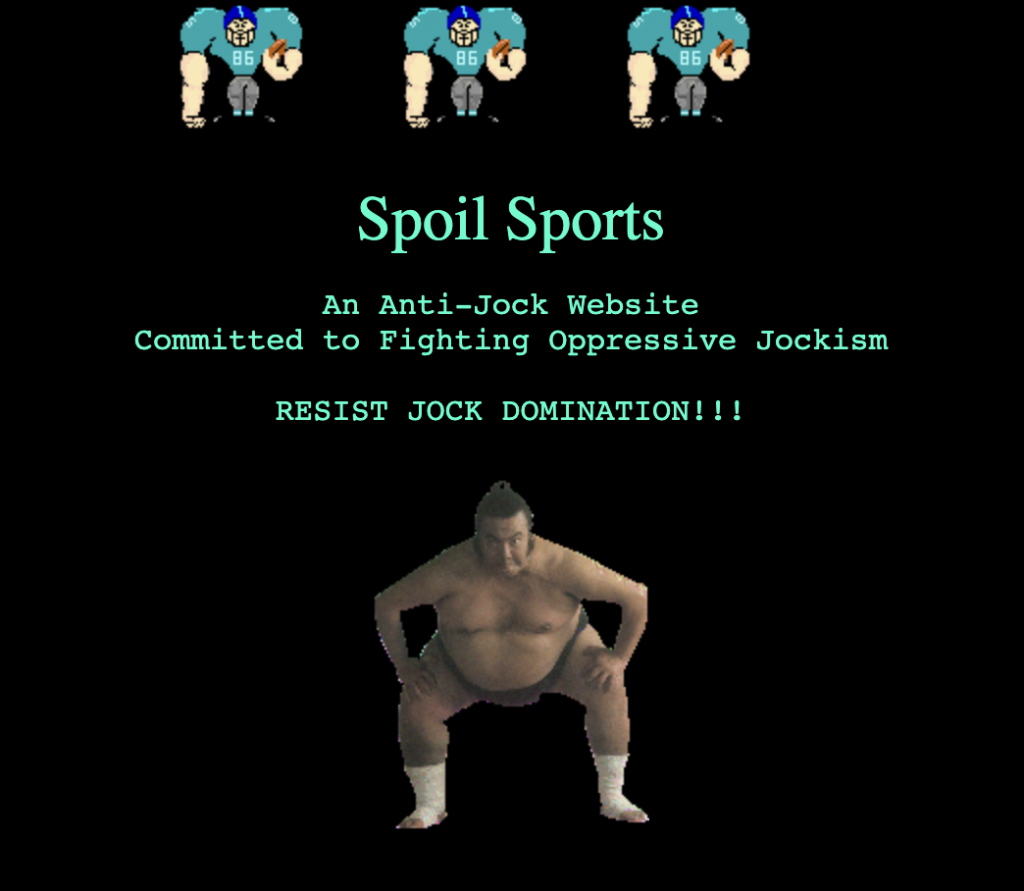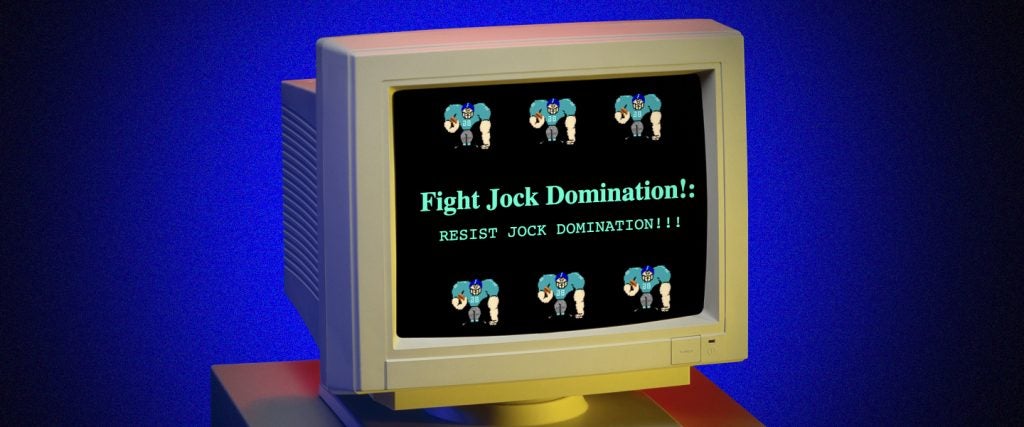Like many American high schools, Columbine was a place where athletes received special treatment. The state wrestling champ was regularly permitted to park his Hummer in a 15-minute parking space all day. No one batted an eye when a football player teased a girl about her body in class since their teacher was also the boy’s coach. And per a 1999 report from the Washington Post, the homecoming king, also a football player, was on probation for burglary.
As such, in the aftermath of Columbine, some suggested that part of what motivated Dylan Klebold and Eric Harris to arm themselves with semi-automatic weapons and shoot up their school was an anti-jock sentiment. According to reports, throughout the massacre in the library, Klebold and Harris ordered that, “All the jocks stand up” and shouted, “Anybody with a white hat or a sports emblem on it is dead.”
Whether this anti-jock sentiment is what helped catalyze the events at Columbine is something we’ll never know. Lots of things have been cited as the culprit over the years — everything from mental illness to Marilyn Manson — with the motivation of such horrific violence almost always impossible to truly explain. What we do know is that after Columbine, a niche internet movement that sought to challenge the cultural dominance of competitive sports emerged online. And its connection to the massacre was clear from the beginning.
Later dubbed the Anti-Jock Movement, this loosely organized ring of websites and webzines first came online in April 1999. According to Brian Wilson, a professor at the University of British of Columbia’s School of Kinesiology, who in 2002 wrote a paper on the trend, the messaging of the movement was surprisingly diverse. “There were different categories of websites that I found — i.e., not all websites shared the same views, and not all anti-jocks felt hard-done-by and/or angry to the same degree, or about the same things exactly,” he tells me. Some clearly outlined their concern as not being “about athletes or sport itself,” but rather “the privilege that’s sometimes associated with involvement in some sports,” Wilson continues.
The most expansive and well-developed of the anti-jock websites were High School Underground, launched in 1999, and Spoil Sports, which came online in 2000. The difference between the two sites, per Wilson, was that while Spoil Sports was dedicated specifically to the Anti-Jock Movement, High School Underground focused more generally on ways for disaffected high school students to express themselves and solve their bullying-related issues.
For example, High School Underground’s homepage featured a link to a survey with questions like: “Have you ever felt like everyone in your high school is braindead?,” “Have you become frustrated that all of the so-called successful students are actually blind followers?” and, pointedly, “Have you ever considered just blowing up the entire school?”

Sameer Parekh, an entrepreneur whose company The Anonymizer let users browse the internet anonymously, was 24 when he first launched High School Underground seven days after the tragedy at Columbine. “The only way to prevent outcast students from exploding into violence is to provide them with alternative means of expressing themselves,” he told the USA Today in 1999. “The popular kids didn’t like me, and rather than being upset and not doing anything about it, I published a newsletter.”
To that end, the website’s “Why Now?” page cited the “recent massacre in Littleton, Colorado” directly. Parekh believed the shooting happened because outcast students “did not have any productive means to express their opinions.”
Somewhat alternatively, Spoil Sports was created “to address the [the sports-related] insanity that goes unchallenged or even acknowledged in everyday life,” says Ray, 63, who created the website. “At the time, there were only two or three pages on the internet with similar themes, and they were single pages. I thought the topic deserved more attention.”

For his part, Ray says that Columbine didn’t inspire him to create the site. Instead, he was called to action by an Australian anti-soccer site that claimed to be in existence for almost 20 years in 2000. (The name of that site evades him as it became defunct several years ago.) “Apparently Australian football is even more annoying than American football, and the author deflated a football every year on its anniversary,” he says.
Ray, like Wilson, isn’t sure who started the Anti-Jock Movement, but believes the sentiment had been around for years. “There’s always been an anti-jock attitude, simmering, just below the surface, especially among academics,” he says. “But I’ve seen a couple of articles over the years where [the Columbine shooting] was exploited to support anti-jock sentiment.”
Nonetheless, both sites were overtly critical of the culture around mainstream sports, especially when it marginalized non-athletes. And both sites supported non-violent, informed approaches to dealing with the cultural dominance of sports on school campuses. According to Wilson, High School Underground primarily focused on “strategies for personal expressions” in the form of webzines. Their resources page included articles with titles like “Channeling Rebellion” and “Reboot America.” The latter of which included an essay by Srini Kumar — the founder of a now-defunct website that sold counterculture stickers and other paraphernalia — that contended, “I think we have a sick society here, and I want things to change.”
Meanwhile, Spoil Sports provided more specific “recipes” for dealing with feelings of disaffection and marginalization, including boycotting school pep rallies, writing letters to local newspapers and referring people to an affiliated webpage that endorsed “tactical retaliatory methods” or “acts of poetic terrorism,” which were inspired by the writing of American anarchist and poet Hakim Bey. In some of the writing on SpoilSports, the enemy is “the Jock-o-ocracy,” and not “some ignorant Jock who thinks he’s better than everyone else.”

In sharp contrast to the generally positive, remedial nature of the anti-jock webzines, the anti-jock personal webpages were more about describing negative individual experiences and expressing anger toward jocks — “rambling rants” that, per Wilson’s paper, were “less concerned with making an informed argument” and more about mocking jocks. Case in point: One refers to jocks as “proto-human, alcoholic, shit-smelling, sweat-oozing, racist sleazebags that look like some repugnant and malformed alien out of a Star Wars movie.”
Another anti-jock personal page called Jock-Itch went as far as to express feelings of empathy with Harris and Klebold’s anger, writing that he “even had the mentality to maim and kill [jocks] just to get even, but that’s troubling to me and I repressed it in the back of my mind.” Subsequently, this same person goes on to denounce his own thoughts of violence since “violence is a jock reaction.”
Most, if not all, of the original advocates of the Anti-Jock Movement, like Ray — who tells me he has plans to pull the plug on his “mostly inactive” site soon — have moved on. No doubt, in part, because subsequent school shootings like Sandy Hook, Marjory Stoneman Douglas and Virginia Tech no longer fit the anti-jock narrative. Or maybe because, a few years later, Reddit and 4chan proved to be a better home to the disaffected male psyche, where a Frankenstein of angry, lonely guys now blame Chads (jocks by another name) for ruining their lives.
As for the founders of the High School Underground and the ring of sites that it linked out to, they simply grew up. Srini Kumar went on to create Tinyvox, an audio recording app for social media platforms, and Sameer Parekh went on to develop autonomous flying robots. All that’s left of their project is a digital cemetery of personal blogs and webzines that capture a specific moment in the immediate post-Columbine world. The fruit it bore, however, is very much up for debate.

